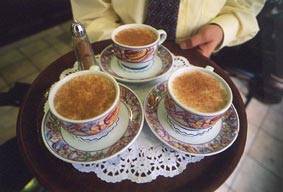|
|
|
|
|
|
|
 With the
coming of cold winter days, Turkey's cake and pudding shops begin serving salep in place
of ice cream. On the ferryboats which ply their way between the European and Asian shores
of Istanbul with smoke trailing from their funnels and chased by flocks of seagulls, many
of the passengers order steaming cups of this delicious warming beverage. Salep is made
from the powdered root of several species of wild orchids, and is both tasty and
nourishing. It keeps the body warm in cold weather and increases resistance against the
colds and coughs of winter. With the
coming of cold winter days, Turkey's cake and pudding shops begin serving salep in place
of ice cream. On the ferryboats which ply their way between the European and Asian shores
of Istanbul with smoke trailing from their funnels and chased by flocks of seagulls, many
of the passengers order steaming cups of this delicious warming beverage. Salep is made
from the powdered root of several species of wild orchids, and is both tasty and
nourishing. It keeps the body warm in cold weather and increases resistance against the
colds and coughs of winter.
The Turks have been drinking salep for many centuries. After they became converted in the 8th century to Islam, a religion which prohibited the consumption of alcoholic drinks like wine and kımız (made from mar'sh milk), non-alcoholic beverages like boza (made from maize), şıra (grape juice) and salep took their place. While şıra was the preferred drink of the summer months, boza and hot salep were the drinks of winter. Also known as çayırotu or çemçiçeği, salep is believed to be good for disorders of the intestines, colds and coughs; improve the appetite and increase virility. Ancient folklore relates that it was an ingredient of love potions brewed by witches. In Ottoman times salep was an ingredient of invigorating pastes prepared for the sultans, along with ginger, coriander, senna, black cumin seeds, coconut, aniseed and numerous other herbs and spices. In winter salep prepared as a drink with milk was sold by street vendors, who kept it warm in large copper jugs on a brazier. Their customers would warm themselves by the brazier and drink salep out of large cups without handles. A traditional drink of the Middle East, salep was introduced to Europe, and became popular, particularly in England, where it was sold in salep shops, and served with bread and butter. Gradually, however, as coffee drinking became widespread, its use in Europe died out. The largest tubers are gathered from orchids growing in forested mountainous regions, while those growing in meadows and high pastures are smaller. They grow best in soil with a high lime content, and those with the finest aroma and richest in starch are found at altitudes of 1000 to 1100 metres. In Anatolia most orchid species belong to the genera Orchis and Ophrys. Wild orchids are most abundant in the provinces of Kahramanmaraş, Adıyaman, Bitlis, and the Black Sea provinces, particularly Kastamonu. They flower in April and May, and then seed. Some of the flowers are scentless, while others produce a sweet scent that is strongest in the evening, and their colours vary from white to various tones of purple.
Salep is expensive, so what is sold as salep may often be made with more cornstarch than the real thing. Therefore, if you do not want to be disappointed, it is better not to drink salep sold in the street. Places to be recommended include the pudding shops of Beyoğlu and along the Bosphorus which are famous for their salep. Even better make it yourself at home, which will save you from going out in cold weather. Salep is simple to prepare. You can buy salep powder from the Mısır Çarşısı (Egyptian Market) in Istanbul, or from other spice shops, and it will keep in a glass jar indefinitely. Just boil up with milk and sugar for a delicious health giving cup of salep.
|
| |
|
Our Hotel | Turkey | Cappadocia | Daily Tours | Views | Guestbook | Request Form | Home |